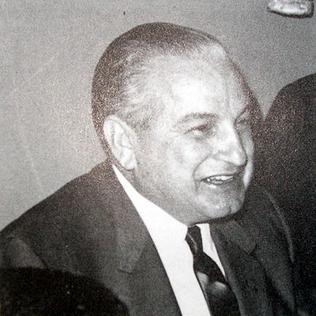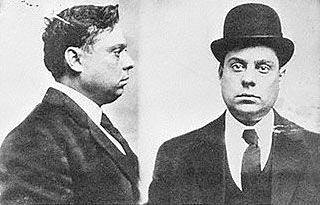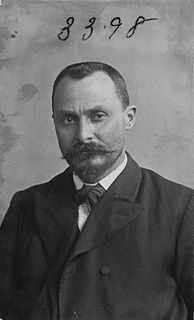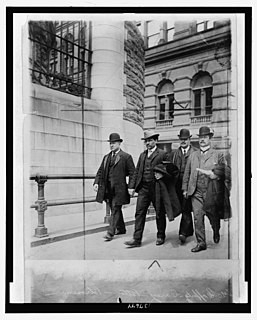Omertà is a Southern Italian code of silence and code of honor and conduct that places importance on silence in the face of questioning by authorities or outsiders; non-cooperation with authorities, the government, or outsiders, especially during criminal investigations; and willfully ignoring and generally avoiding interference with the illegal activities of others. It originated and remains common in Southern Italy, where banditry or brigandage and Mafia-type criminal organizations have long been strong. Similar codes are also deeply rooted in other areas of the Mediterranean, including Malta, Crete in Greece, and Corsica, all of which share a common or similar historic culture with Southern Italy.

Santo Trafficante Jr. was among the most powerful Mafia bosses in the United States. He headed the Trafficante crime family and controlled organized criminal operations in Florida and Cuba, which had previously been consolidated from several rival gangs by his father, Santo Trafficante Sr.
Zips is a slang term in the United States that was especially in use in the early 20th century. It was often used as a derogatory slur by Italian American and Sicilian American mobsters in reference to newer immigrant Sicilian and Italian mafiosi. The mobsters in the US were said to have difficulty understanding the Sicilian dialects of the new immigrants, in which words appeared to "zip" by. Other theories include pejorative uses, such as Sicilians' preference for homemade zip guns. According to another theory, the term is a contraction of the Sicilian slang term for "hicks" or "primitives". The older Sicilian mafiosi of the pre-Prohibition era, known as "Mustache Petes", were also referred to as "zips". They were deposed by American-born mobsters during the Castellammarese War.
The Sicilian Mafia, also simply known as the Mafia and frequently referred to as Cosa nostra by its members, is an Italian Mafia-terrorist-type organized crime syndicate and criminal society originating in the region of Sicily and dating to at least the 19th century. It is a loose association of criminal groups that share a common organisational structure and code of conduct and honor and present themselves to the public under a common brand. The basic group is known as a "family", "clan", or cosca. Each family claims sovereignty over a territory, usually a town or village or a neighbourhood (borgata) of a larger city, in which it operates its rackets. Its members call themselves "men of honour", although the public often refers to them as mafiosi. By the 20th century, following wide-scale emigration from Sicily, mafiosi established gangs in North and South America which replicate the traditions and methods of their Sicilian ancestors. The Mafia's core activities are protection racketeering, the arbitration of disputes between criminals, and the organizing and oversight of illegal agreements and transactions.
Nicolò Terranova, also known as Nicholas "Nick" Morello, was one of the first Italian-American organized crime figures in New York City he succeeded Giuseppe Morello as boss of the then Morello Gang in 1909 and was succeeded by Vincenzo Terranova in 1916. Along with his half-brother Giuseppe Morello and brothers Ciro and Vincenzo Terranova, he founded the Morello crime family, and was later one of the participants in the Mafia-Camorra War of 1915–17.

Carlos Joseph Marcello was an Italian-American crime boss of the New Orleans crime family from 1947 until the late 1980s.
Manfredi "Al" or "Alfred" Mineo was a Brooklyn-based New York mobster, who headed a strong American Mafia crime family during the Castellammarese War. Mineo's organization would eventually become the present-day Gambino crime family.

The Morello crime family was one of the earliest crime families to be established in the United States and New York City. The Morellos were based in Manhattan's Italian Harlem and eventually gained dominance in the Italian underworld by defeating the rival Neapolitan Camorra of Brooklyn. They were the predecessors of what eventually became known as the Genovese crime family.

Ignazio Lupo, also known as Ignazio Saietta and Lupo the Wolf, was a Sicilian American Black Hand leader in New York City during the early 1900s. His business was centered in Little Italy, Manhattan, where he ran large extortion operations and committed other crimes including robberies, loan-sharking, and murder. By the start of the 20th century, Lupo merged his crew with others in the South Bronx and East Harlem to form the Morello crime family, which became the leading Mafia family in New York City.

Vito Cascio Ferro or Vito Cascioferro, also known as Don Vito, was a prominent member of the Sicilian Mafia. He also operated for several years in the United States. He is often depicted as the "boss of bosses", although such a position does not exist in the loose structure of Cosa Nostra in Sicily.

Michele Greco was a member of the Sicilian Mafia and a convicted murderer. Greco died in prison while serving multiple life sentences. His nickname was Il Papa due to his ability to mediate between different Mafia families. Greco was the head of the Sicilian Mafia Commission.

Organized crime in Italy and its criminal organizations have been prevalent in Italy, especially Southern Italy, for centuries and have affected the social and economic life of many Italian regions since at least the 19th century.

Joseph Petrosino was an Italian-born New York City Police Department (NYPD) officer who was a pioneer in the fight against organized crime. Crime fighting techniques that Petrosino pioneered are still practiced by law enforcement agencies.
The Mafia–Camorra War was a gang war in New York City that lasted from 1915-1917. On one side was the originally Sicilian Morello crime family of Manhattan; on the other side were gangs originally from Naples and the surrounding Campania region, based in Navy Street in Brooklyn and Coney Island referred to as the Camorra. The fight over the control of the New York rackets started after the killing of Giosue Gallucci, the undisputed King of Little Italy, and his son on May 17, 1915. The trials that followed in 1918 completely smashed the Camorra gangs; the protection that they enjoyed was demolished from the testimonies of their own men. It was the end of the Camorra in New York and the rise in power of American-based Sicilian Mafia groups.
The New Orleans crime family was an Italian-American Mafia crime family based in the city of New Orleans. The family had a history of criminal activity dating back to the late nineteenth century. The family reached its height of influence under bosses Silvestro Carollo and Carlos Marcello. In the 1960s, due to Marcello’s stubborn refusal of inducting new members into the family, they dwindled down to a paltry 4 or 5 made men with hundreds of associates throughout the United States. However, the Federal Bureau of Investigation believed there were a bit over 20 made men at the time, or 20+ associates so close to Marcello and to each other, that they were considered a formal part of the New Orleans’ family hierarchy. A series of setbacks during the 1980s reduced its clout, and law enforcement dismantled most of what remained shortly after Marcello's death in 1993. In spite of this, it is believed that at least some elements of the American Mafia remain active in New Orleans today.
The Second Mafia War was a period of conflict involving the Sicilian Mafia, mostly taking place from the late 1970s to the early 1990s and involved thousands of homicides. Sometimes referred to as The Great Mafia War or the Mattanza, it involved the entire Mafia and radically altered the power balance within the organization. In addition to the violence within the Mafia itself, there was violence against the state, including a campaign of deliberate assassinations of judges, prosecutors, and politicians. In turn, the war resulted in a major crackdown against the Mafia, helped by the pentiti, Mafiosi who collaborated with the authorities after losing so many friends and relatives to the fighting. In effect, the conflict helped end the secrecy of the Mafia.

Tommaso "The Ox" Petto was a New York mobster and leading hitman in the Morello crime family during the early 1900s.
The American Mafia, commonly referred to in North America as the Italian-American Mafia, the Mafia, or the Mob, is a highly organized Italian-American criminal society and organized crime group. The organization is often referred to by its members as Cosa Nostra and by the American government as La Cosa Nostra (LCN). The organization's name is derived from the original Mafia or Cosa nostra, the Sicilian Mafia, with "American Mafia" originally referring simply to Mafia groups from Sicily operating in the United States, as the organization initially emerged as an offshoot of the Sicilian Mafia formed by Italian immigrants in the United States. However, the organization gradually evolved into a separate entity partially independent of the original Mafia in Sicily, and it eventually encompassed or absorbed other Italian immigrant and Italian-American gangsters and Italian-American crime groups active in the United States and Canada that were not of Sicilian origin. In North America, it is often colloquially referred to as the Italian Mafia or Italian Mob, though these terms may also apply to the separate yet related Sicilian Mafia or other organized crime groups in Italy or ethnic Italian crime groups in other countries.